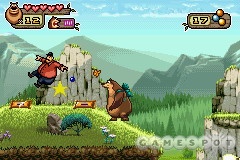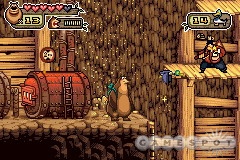You probably aren't surprised to learn that the Game Boy Advance rendition of Open Season is a side-scrolling action game. What may surprise you, however, is that this game is some kind of crazy "Metal Slug meets Mario" hybrid, where hunters are constantly showering you with hatchets and bullets as you jump and climb over things and where you're attacking these same hunters with weaponized rabbits and beavers that function more like baseball bats and grenades than cute furry animals. It's fast paced, it's bizarre, and it's actually a good deal of fun.

The game is loosely based on the computer-animated film of the same name. You have to help Boog, a city-dwelling grizzly bear, make his way through a forest filled with hunters and wild animals so that he can return to his cushy home in the city. This journey has been distilled onto the GBA as six side-scrolling levels, each consisting of multiple sections filled with the aforementioned hunters and animals, as well as a boss battle at the end.
Thematically, the game has a vibe akin to side-scrolling shooters like Contra or Metal Slug, in spite of the fact that the characters and story come from a family-friendly animated movie. The levels have the usual assortment of gaps and platforms, but there are also many alternate paths and hideaways to discover. Candy bars, which let you buy upgrades to Boog's abilities, are hidden everywhere and give you incentive to seek out these secret spots. There's never a slow moment, thanks to all of the hunters and cranky animals that are constantly assailing Boog with nuts and bullets. Boog is a versatile bear, though, and can handle anything the levels dish out. You can jump, duck, and roll past most hazards and use Boog's claws to climb nearly every vertical surface in the game. Boog can roar at enemies to stun them and smack them with his backpack to scare them off, but his real arsenal consists of all the animals he can pick up and use as weapons. Rabbits, squirrels, beavers, ducks, and skunks can be picked up and swung around like clubs or thrown as projectiles. Each has its own wacky use. Ducks, for example, fly toward enemies like heat-seeking missiles, whereas skunks function more like grenades in that they explode into a puff of green stink.
Similar thought and care went into the graphics and audio. The backgrounds are diverse and rich with color, and they make use of multiple scrolling layers to lend a sense of depth to the otherwise two-dimensional scenery. Some levels incorporate neat little visual effects, such as moving clouds, transparent water, and falling rain. The characters are large and colorful and have a wide variety of animations. When you free Reilly the beaver from a trap, he fires up his chainsaw and cuts a doorway out of any trees that are blocking your path. Furthermore, all of the different animations and transitions between them are so smooth and seamless that the characters look more like cartoon animals than video game sprites. If there's any negative to the graphics, it's that there are only so many animals and hunters in the game, so you'll end up seeing the same objects countless times in each level--not that it's a huge negative, since you'll usually be too busy dodging bullets to care that you've come across the same hunter three times in a row. The story itself is told through a series of comic-book-style cinematic scenes brought to life with animated facial expressions and floating speech bubbles.
There's no voice acting in the cinematics, but some of the many sound effects you'll hear during the game employ vocalizations taken from the movie. Boog's growl, McSquizzy's scream, and Reilly's chainsaw are the most obvious examples. As it is, there are loads of different sound effects for everything that the characters do, as well as for environmental atmosphere. Each level has its own distinctive background music. The tunes come across as repetitive, and a couple of them seem overly dramatic considering the subject matter, but they're otherwise very rich. For once, music coming out of the GBA speaker sounds more like an MP3 you'd listen to and less like a couple of beats generated by a computer chip.
If you do decide to pick this one up, make sure you play it on the hard difficulty setting. When you start a new game, you can pick from easy or hard. On the easy setting, there are health-restoring goldfish crackers all over the place, and enemies run off after one measly hit. The hard setting is better balanced and ultimately more satisfying. Items are less plentiful and are strategically placed, enemies take more hits before they fall, and bosses endure long enough that you actually have to try to avoid their attacks.

The big downfall is that the game is too short. There are only six different levels to play and you'll need only an hour or so to finish them all. There aren't any bonus levels or minigames to unlock, so once you've run through all six levels, you've pretty much experienced all that Open Season on the GBA has to offer. While it certainly helps that the levels beg to be replayed in the same way that the levels in classics like Contra or Metal Slug beg to be replayed, it's hard to imagine anyone going through them more than two or three times each. It's a good time while it lasts, but a few more levels would have been nice.
Regardless, this is one movie tie-in that fans of the movie can feel good about playing. Open Season on the GBA may not have lots of levels, but it is sharply put together and a fun ride from start to finish.